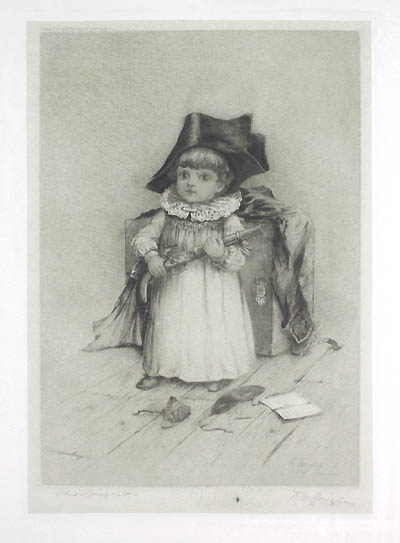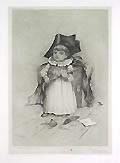| Title: |
Little Dick Turpin (Richard Turpin, The Highwayman) |
| Engraver: |
Spiegle, Frederick M. (New York, 1863 - 1942) |
| Designer: |
Spiegle, Charles (New York, active, 19th century) |
| Date: |
1891 |
| Medium: |
Original Etching (Remarque Proof Impression) |
| Publisher: |
C. Klackner, New York |
| Edition: |
Signed, Remarque Proof Impression on China Paper |
| Note: |
Frederick M. Spiegle 'Frederick Spiegle': A New York City etcher and painter, Frederick M.
Spiegle studied art in Paris. In the United States, Spiegle exhibited his
art with such societies as the New York Etching Club, the Society of Independant
Artists and the Salons of America. He was also regularly commissioned by
publishers for book illustrations. |
| |
Most of Frederick Spiegle's etchings were published by the
New York company of C. Klackner (Christian Klackner). Frederick M. Spiegle
specialized in genre scenes, both after his designs
and those of others. Little Dick Turpin bears the signatures of
both F. M. Spiegle and a Charles Spiegle. This charming portrayal was a
collaboration between Frederick Spiegle and his brother or father. |
| |
The Nineteenth Century Remarque Proof Impression: In the late 19th century
American and British publishers of large engravings and etchings would
produce a small number of remarque proofs before publication of the regular
edition. 'Remarque' refers to the small etching (in this case a spider
in a cobweb) found under the main image in the lower margin. Remarques
were meant to compliment the composition, and were removed for the publication
of the regular edition. 'Proofs' were the first impressions to be pulled
from the plate and before the addition of the title along the lower margin.
Proofs thus constitute the finest impressions. As well, in the Victorian
era, Proofs were printed on special papers, such as China or India
papers, or on expensive materials such as silk or vellum. Remarque Proofs
were the only impressions which were hand-signed by the artists. The
Remarque in this original etching depicts a spider in the center of its web. |
| |
The New York firm of C. Klackner, published original etchings by
late 19th and early 20th century artists and designers such as, Winslow Homer, William
Magrath, James S. King, Frederick Spiegle, Charles Spiegle, John T. Bentley, Gustave Mercier, Leon Moran,
Eugene Michel Joseph Abot, Edward W. Sharland, James Scott and John George Brown and other
notable artists from this period. Frederick Spiegle's original etching,
Little Dick Turpin is a striking example of the art published by Christian Klackner. |
| |
Richard Turpin 'Dick Turpin' (1706-1739): The famous English highwayman, Dick Turpin was the son
of an innkeeper at Hempstead, Essex. He was a member of the notorious Essex gang. The gang members were eventually captured, imprisoned
and or executed for their crimes. Turpin had somehow managed to escape the authorities and continued with his wicked ways, this
time highway robbery. Nonetheless, like the Essex gang, he was finally arrested and accused of stealing horses. At that
time, this crime had the severe penalty of death by hanging. In 1739, after being found guilty of the crimes of theft and murder,
Dick Turpin was executed in York. |
| |
Richard (Dick) Turpin, was also known by the assumed name of John Palmer. He was one of William Harrison Ainsworth's (1805-1882), characters in his novel, Rookwood published in 1834. In this novel, Ainsworth, gives an account of
Dick Turpin's great ride to York on Black Bess. In the process of writing his story, William Harrison Ainsworth completely recreates Turpin's character, making him out to be more of a charming Robin Hood like personality. This novel was to seal the legend of the hero, Dick Turpin and his famous ride from London to York in a single night (which, by the way, is fictional). During the 19th and following centuries, replays of Dick Turpin's story (as told by Ainsworth), appeared in magazines, cheap novels and ballads around the world, such as the Penny Dreadful of 1866-1868 entitled, Black Bess or the Knight of the Road which featured Dick Turpin's famous ride, the weekly magazine, The Life of Richard Palmer; better known as Dick Turpin, The Notorious highwayman and Robber by Henry Downes Miles, published by Thomas White (1839), The Blue Dwarf, A tale of Love Mystery and Crime introducing many startling incidents in the life of that celebrated highwayman, Dick Turpin by Percy Bolingbroke St. John,
London Hogarth House, (1884) and many other similar works. |
| |
As it is, the legend of the famous English highwayman or bandit, Dick Turpin is still with us today. Throughout the 20th century, many films and or TV series portraying the life of Dick Turpin were produced. A few include the 1906 film written and starred by Fred Ginnett entitled, Dick Turpin's Last Ride to York and in the 1974 film, Carry On Dick the actor Sid James appeared as Turpin. The British television drama series Dick Turpin (1979-1982), was loosely based upon the legendary 18th century English rogue, Dick Turpin. This series stars Richard O'Sullivan, Michael Deeks Christopher Benjamin and others, produced by Gate, Seacastle productions in association with London Weekend Television. And of course, Walt Disney productions also entered the scene with their classic 1966 children's action and adventure swashbuckler entitled, The Legend of Young Dick Turpin, starring David Weston, Bernard Lee, George Cole Maurice Denham, William Franklyn and others. |
| |
This original etching entitled, Little Dick Turpin depicts Turpin as a boy or a child impersonating the famous bandit. The little boy is dressed in an 18th century night shirt and he is also wearing a wide brimmed hat similar to those worn by highwaymen. He is standing at attention in front of a large chest draped with a man's traveling overcoat. The child is holding a massive pistol (a flintlock), across both arms to balance its weight. There is a distinctive robber's mask, a rose and a small notebook laying on the floor. All of these items are suggestive of Turpin's romanticized activities. Altogether, a very pleasing and a most interesting portrayal of the famous highwayman Dick Turpin. Aside from a 1954 advertisement of Dick Turpin depicted as a young boy robbing the Quaker Puffed Wheat packet, (The logo read; "Stand and Deliver Puffed Wheat"), I have seen no other depiction of the legendary highwayman as a child. |
| Size: |
20 X 13 1/2 (Sizes in inches are approximate, height preceding width of plate-mark or image.) |
| |
Unmatted |
| Buy Now |
Price: $625.00 US |
| Condition: |
Printed upon fine China paper and impressed onto a sheet of white, wove
paper and with full margins as published in New York by Christian Klackner in 1891.
Signed and dated in the plate and signed in pencil by both artists along
the lower margin. Containing several small scraping marks within the etching
to the lower left, else a brilliant proof impression and in good condition
throughout. Little Dick Turpin represents a prime, original example of
the etched art of F. M. Spiegle. |
| Important Information: |
The artist biographies, research and or information pertaining to all the original works of art posted on our pages has been written and designed by Greg & Connie Peters exclusively for our site, (www.artoftheprint.com). Please visit us regularly to view the latest artworks offered for sale. We will soon be posting an update of our most recent research and include the biographical and historical information pertaining to our next collection of original works of art created by artists throughout the centuries. We hope you found the information you were looking for and that it has been beneficial.
Our Gallery, (Art of the Print / www.artoftheprint.com) guarantees the authenticity of every work of art we sell 100%. Full documentation and certification is provided. We offer a wide selection of international fine art dating from the early Renaissance to the contemporary art period. |
















![]()
![]() or
phone Greg & Connie (905) 957-6666
or
phone Greg & Connie (905) 957-6666